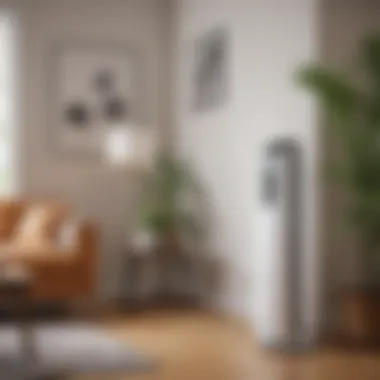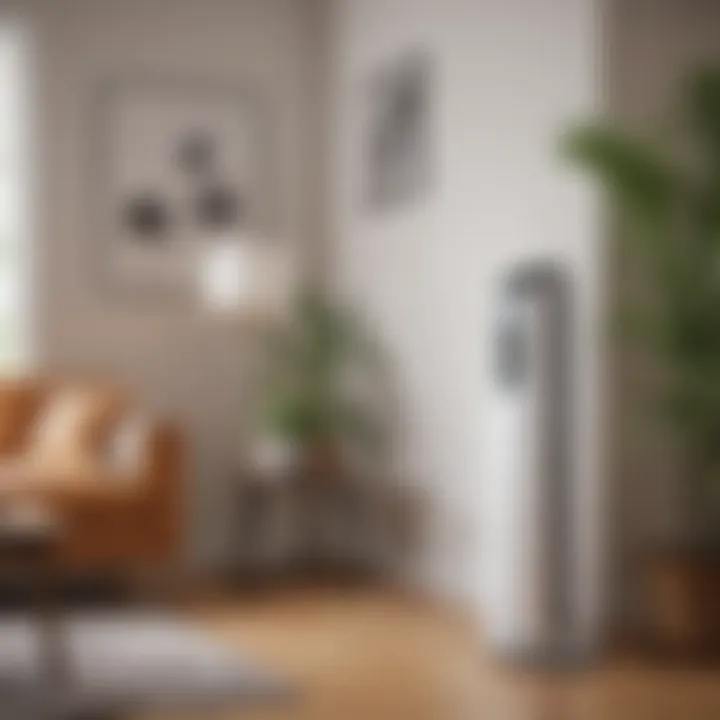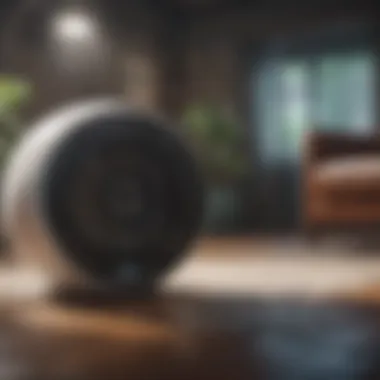Evaluating the Safety of Ozone Air Purifiers


Intro
When it comes to purifying the air we breathe at home, ozone air purifiers have garnered a fair share of attention. Marketed with promises to eliminate pesky pollutants and lingering odors, these devices can be tempting. However, recent conversations have shifted towards understanding the implications of ozone exposure on our health and the well-being of our pets.
For those navigating this world of air purification, it’s critical to assess not only the effectiveness of these gadgets but also the potential hazards they may introduce into our living spaces. In this piece, we’ll untangle the complexities surrounding ozone air purifiers, exploring their functionality, evaluating their safety, and providing insights into suitable alternatives for maintaining clean air in our homes.
Understanding Ozone and Air Purifiers
Air purifiers are designed to enhance indoor air quality. Yet, some models release ozone, a gas that can be destructive at high concentrations. This section aims to clarify how ozone works and its implications when combined with air purifiers.
What is Ozone?
Ozone is a triatomic molecule composed of three oxygen atoms, mainly formed in the atmosphere through reactions between sunlight and pollutants like volatile organic compounds (VOCs) and nitrogen oxides. While ozone high in the atmosphere protects us from ultraviolet radiation, at ground level, it can be harmful.
How Do Ozone Air Purifiers Work?
Ozone air purifiers typically generate ozone through an electrical discharge, supposedly neutralizing pollutants and odors. Devices like the Air Oasis 5000 or the GermGuardian AC5250PT advertise enhanced air cleaning by producing ozone. However, the effectiveness of these purifiers relies heavily on the concentration of ozone they emit and the duration of exposure.
- Mechanism of Action: When ozone encounters pollutants, it breaks them down. It can reduce odors, bacteria, and other harmful particles. But at what cost?
- Health Considerations: Research shows that even low levels of ozone can irritate the respiratory system, leading to cough, chest pain, and even exacerbating conditions such as asthma or allergies.
Evaluating Ozone Exposure
Ozone exposure is a pressing concern for both humans and pets. This section dissects its potential health implications.
Impact on Humans
Can ozone in the home put families at risk? Studies indicate prolonged exposure to ozone can be detrimental, leading to both short-term and long-term health issues. Vulnerable populations, such as children and the elderly, are particularly at risk.
Effects on Pets
Our furry companions are not immune. Pets, especially those with pre-existing respiratory conditions, can suffer from the same consequences as humans. Common symptoms may include:
- Persistent coughing
- Increased respiratory rate
- Fatigue and lethargy
It’s important for pet owners to stay vigilant and recognize these symptoms promptly.
“While striving for fresh air in the home, we must not overlook the sources of potential harm that come with it.”
Regulatory Stance and Recommendations
Many health organizations express concern about the use of ozone generators in unoccupied spaces. The U.S. Environmental Protection Agency warns that ozone can cause more harm than good.
Recommended Alternatives
Fortunately, options abound that do not present this risk:
- HEPA Filters: Highly effective in trapping airborne particles.
- Activated Carbon Filters: Excellent for neutralizing odors without ozone emission.
- UV Light Air Purifiers: Kill bacteria and viruses using ultraviolet rays without generating harmful byproducts.
By relieving those in the know and incorporating safe alternatives, we can enjoy cleaner, healthier air without subjecting ourselves or our pets to the risks posed by ozone.
Epilogue
The quest for cleaner air should not come at the expense of health. As we’ve discussed, ozone air purifiers bring forward a complicated relationship with indoor air quality. Beyond just the allure of sweet-smelling air, it’s essential to weigh the safety concerns and explore more reliable alternatives. Each step towards understanding these dynamics can lead to a safer, healthier home environment for everyone—two-legged and four-legged alike.
Prelude to Air Purification
As indoor environments become increasingly complex ecosystems filled with various pollutants, understanding air purification takes on a crucial role. The importance of purifying the air we breathe can’t be overstated, especially in homes where vulnerable occupants like children and pets reside. A well-ventilated space isn’t just a luxury; it’s a necessity for health and well-being.
Air purification technologies, including ozone air purifiers, have garnered significant attention in recent years. These devices promise to eliminate airborne toxins, allergens, and even unpleasant smells, making it seem as though they are a silver bullet for achieving superior air quality. However, the effectiveness and safety of such devices are often shrouded in ambiguity. This article aims to shed light on the different technologies available, with a particular focus on ozone-based systems, as we unravel the complexities behind their claims and the implications they may have for household safety.


Overview of Air Purification Technologies
When diving into the realm of air purification, it’s essential to understand the variety of technologies that exist. Here’s a brief overview:
- Filtration: HEPA (High Efficiency Particulate Air) filters trap particles like dust and pollen, purifying the air without the introduction of any additional chemicals.
- UV Light: Ultraviolet light purifiers work to kill bacteria and viruses using shortwave radiation, effectively sanitizing the air.
- Ionization: Some purifiers use ionization to attract and trap particles in the air, though this method can sometimes create ozone as a byproduct.
- Ozone Generators: These devices produce ozone intentionally, marketed for their ability to break down pollutants but raising significant safety concerns regarding ozone exposure.
Each of these technologies has its pros and cons, and the choice often depends on specific needs, like the types of allergens present or the size of the area to be purified. The challenge lies in identifying which method provides the best results without compromising health, especially when discussing ozone air purifiers.
The Role of Ozone in Air Quality
Ozone, a molecule comprised of three oxygen atoms, is often viewed as a double-edged sword in air quality discussions. While it forms a protective layer in the atmosphere, shielding the Earth from harmful UV radiation, its lower-altitude presence—especially indoors—can pose substantial health risks. Ozone is a potent oxidant, capable of neutralizing some pollutants. However, its byproducts can irritate respiratory systems and exacerbate existing health conditions.
The debate surrounding ozone air purifiers revolves around this very paradox. Proponents hail ozone's capability to eliminate odors and disinfect spaces, leading many to consider these devices as beneficial. Nevertheless, when utilized improperly or in uncontrolled environments, ozone levels can spike, potentially leading to adverse health effects. Thus, understanding how ozone interacts with indoor air quality is vital before succumbing to the allure of ozone-generating devices.
"The benefits of air purification are significant, but the role of ozone within that framework must be approached with caution. In trying to improve our environment, we might inadvertently harm it."
Through the rest of this article, we will explore these matters in greater depth, analyzing the claims made by ozone air purifiers and the potential health risks involved, particularly for those living with pets or small children. With a careful assessment, we will highlight how to navigate this intricate field of air purification.
Understanding Ozone Generation
Understanding how ozone is generated is crucial in assessing the safety and effectiveness of ozone air purifiers. This technology has gained some traction in the market, often touted for its ability to improve indoor air quality by eliminating undesirable odors and pollutants. However, it is essential to peel back the layers and grasp what ozone is, how it’s created, and what implications it holds for our health, especially in environments shared with pets and children.
Ozone, a molecule composed of three oxygen atoms, exists naturally in the earth's stratosphere, where it plays a vital role in absorbing harmful ultraviolet radiation. In contrast, ground-level ozone can be a different beast entirely; it forms when pollutants emitted from cars, industrial facilities, and other sources undergo chemical reactions in the presence of sunlight. While ozone may serve to clear the air, in high concentrations, it can lead to a host of health issues. This duality raises questions about the safety of utilizing ozone-generating devices indoors.
How Ozone Generators Work
Ozone generators create ozone through various processes. One of the primary methods is corona discharge, where electrical discharges break apart oxygen molecules in the air (O2) to form ozone (O3). Essentially, the generator pushes air through an electrical field, mimicking the natural phenomenon that occurs during thunderstorms when lightning strikes cause oxygen molecules to split and recombine as ozone. Though this sounds efficient, the concern lies in the fact that ozone can be detrimental to health, especially in enclosed spaces.
The efficacy of these devices often comes with a health warning. While it might seem like a smart solution, generating ozone at home can lead to increased indoor ozone levels, which may result in respiratory issues, skin irritations, and other health problems. It's imperative to assess whether the benefits really outweigh the risks if you choose to invite these devices into your home.
Types of Ozone Generators
Ozone generators come in a few different varieties, each intended for specific applications:
- Portable Ozone Generators: These are small, convenient units that can be moved from room to room, making them appealing for household use.
- Commercial-Grade Ozone Generators: Typically used in larger settings, such as hotels and commercial buildings, they produce higher ozone levels and are primarily used for mold remediation and odor elimination.
- HVAC Ozone Generators: Installed in heating, ventilation, and air conditioning systems, these units aim to purify larger areas but can easily contribute to excessive ozone levels if not properly managed.
It's vital for users to be aware of the specific output levels these devices produce and to consider how they could impact health, particularly in homes with children or pets.
"Installing an ozone generator without proper knowledge of its functioning can lead to more harm than good."
At the end of the day, knowing how ozone generators operate and the types available gives potential users the insight needed to make informed decisions. Understanding their operation empowers consumers to evaluate whether these devices are suitable—or even safe—for their living environments.
The Claims of Ozone Air Purifiers
The topic of ozone air purifiers is surrounded by a mix of marketing claims and consumer apprehensions. Understanding these claims is essential for pet owners and families, especially when considering the health implications for both humans and animals in household environments. Ozone air purifiers often promote their ability to remove pollutants and allergens, leading many to believe they are a perfect solution for improved air quality.
Promised Benefits
Among the key claims made by manufacturers of ozone air purifiers are the following:
- Odor Removal: Ozone is touted as an effective deodorizer. It's said to neutralize unpleasant smells by breaking down odor-causing molecules.
- Air Sanitization: Proponents argue that ozone can kill bacteria and other pathogens in the air, potentially making the environment safer.
- Allergen Reduction: Some users believe that ozone can contribute to a reduction in allergens, particularly for those sensitive to dust, pet dander, or pollen.
However, it's worth noting that the evidence supporting these claims is often inconclusive. Studies have shown that while ozone can interact with particulates in the air, its effectiveness in a closed environment, like a home, may not be as beneficial as suggested. Moreover, the ozone levels required for these alleged benefits can often exceed safe limits.
Limitations and Misconceptions
Despite the claimed benefits, there are significant limitations and misconceptions associated with ozone air purifiers. Here are a few considerations:
- Safety Concerns: Perhaps the most pressing concern relates to the safety of ozone. High levels of ozone can cause respiratory issues and exacerbate other health problems. This creates a stark contrast to the reassuring claims made by manufacturers.
- Misunderstanding Ozone: Many users conflate ozone with oxygen, assuming that because it contributes to air quality, it is harmless. In reality, ozone can be a pollutant, especially indoors where ventilation is typically limited.
- Regulatory Oversight: Organizations like the Environmental Protection Agency caution against the use of ozone generators. Their guidelines highlight that ozone at levels produced by these devices can be more harmful than beneficial.
To put this into perspective, many owners might set up an ozone generator intending to create a clean living space for their pets, but it could lead to unintended consequences. Understanding these nuances is critical, as a good intention cannot outweigh the risks of potential harm to both humans and animals in the household.


It's important to inform yourself about these claims, as not all that glitters is gold in the realm of ozone air purifiers.
The blend of appealing promises with stark realities makes the discussion on ozone air purifiers even more relevant. Knowledge empowers consumers to make informed choices while balancing the desire for clean air with the responsibility of ensuring a safe environment.
Health Implications of Ozone Exposure
Understanding the health implications of ozone exposure is crucial for anyone considering the use of ozone air purifiers, especially in homes with pets or children. Ozone, while often touted for its supposed air-cleansing abilities, presents various risks that can impact overall well-being. The stakes are higher for vulnerable populations, including young children, the elderly, and individuals with preexisting respiratory conditions. This article will dissect how ozone interacts with human and animal physiology, laying bare potential dangers and unearthing neglected considerations that every pet owner and family must understand.
Effects on Human Health
When ozone enters the human body, particularly through inhalation, it can wreak havoc. This compound is a powerful oxidant, meaning it can actively damage the cells lining the respiratory system. Short-term exposure can trigger a slew of symptoms such as coughing, throat irritation, and chest discomfort. Furthermore, studies indicate that ozone exposure correlates with exacerbating asthma attacks and worsening chronic lung diseases.
- Research from the Environmental Protection Agency has shown that ozone can significantly impair lung function, especially during physical exertion.
- A 2019 study concluded that ozone exposure may also exacerbate allergies, leading to increased sensitivity and inflammation in the airways.
In licensed medical circles, it's widely acknowledged that prolonged exposure can precipitate the development of respiratory illnesses. What’s more alarming is the fact that even short-term exposure can have lasting implications for lung health, challenging assumptions that recovery is always immediate.
Impact on Pets
The health of our furry companions deserves equal attention when discussing ozone exposure. Pets, particularly dogs and cats, tend to breathe more rapidly than humans, resulting in a higher intake of pollutants. Just as ozone can irritate human airways, it similarly affects pets, leading to coughing, wheezing, and even pneumonia in severe cases.
- There is a notable lack of extensive research on the long-term effects of ozone on pets, but anecdotal evidence suggests that chronic exposure can lead to similar respiratory issues observed in humans.
- Unfortunately, pets often exhibit symptoms differently than humans, making it hard to gauge their discomfort until significant distress occurs.
It's essential for pet owners to be mindful of ozone levels in their environment and consider alternatives that protect their beloved animals from risky air quality situations.
Long-term Exposure Risks
The long-term consequences of ozone exposure remain an area of persistent concern. Research aggregates indicate that chronic exposure could lead to irreversible lung damage over time. This can manifest in various forms, from diminished lung function to the potential onset of diseases like Chronic Obstructive Pulmonary Disease (COPD).
"Chronic exposure to ozone may cause lasting damage to lung tissue, potentially leading to serious respiratory illnesses."
- Anxiety and insomnia can also emerge as secondary concerns, indirectly stemming from chronic health issues related to continued ozone exposure.
- Furthermore, there are possible implications for cardiovascular health; some studies link elevated ozone levels to increased risks of heart attacks and strokes.
In summary, while ozone air purifiers may appear to offer benefits at first glance, potential health implications warrant careful consideration. Awareness and understanding are key in determining whether the use of these devices aligns with the goal of securing a safe and healthy environment for families, especially those with pets.
Scientific Research and Findings
When it comes to understanding the safety of ozone air purifiers, the role of scientific research cannot be overstated. It serves as a beacon, illuminating the shadows of uncertainty that often cloud judgments about emerging technologies in air purification. With every new study, we gain insights into the actual effectiveness and safety implications of these devices, guiding consumers and families in their quest for cleaner, healthier air. Through rigorous investigations, researchers assess claims made by manufacturers and separate fact from fiction, making scientific findings essential for informed decisions.
Studies on Ozone Effectiveness
Various studies have sought to determine how effective ozone generators truly are in improving indoor air quality. Research often points out that while ozone can interact with some pollutants and potentially reduce certain odors, the overall net benefit might not measure up to expectations. For example, a study conducted by researchers at the University of California found that ozone could remove some indoor air contaminants, but not all species, leading to the conclusion that reliance solely on these devices may not suffice. It is essential for users to be aware that ozone may fail to address larger particulate matter or underlying issues contributing to poor air quality.
Furthermore, the efficacy of ozone can vary based on factors such as concentration levels and the specific environment in which it is used. High concentrations of ozone, while touted for short-term results, can be harmful. A balanced approach that combines ozone with other air purification methods might yield better results, ensuring a comprehensive solution to indoor pollution.
Regulatory Perspectives
The importance of regulatory guidelines in assessing ozone air purifiers lies in consumer protection. These regulations help establish safe limits for ozone exposure and guide manufacturers in developing products that do not pose undue risk to health or the environment.
Environmental Protection Agency Guidelines
The Environmental Protection Agency, commonly known as the EPA, has formulated guidelines regarding indoor air quality that directly address ozone emissions. One key characteristic of these guidelines is the emphasis on maintaining indoor ozone levels below 0.05 parts per million (ppm). This threshold represents a safety benchmark to protect occupants from potential respiratory issues and other health effects associated with elevated ozone levels. Moreover, the EPA’s recommendations provide clarity on various ozone-generating technologies, helping consumers make safer choices.
A unique feature of the EPA guidelines is their focus on alternatives to ozone generators, encouraging the use of proven technologies like HEPA filters or activated carbon filters instead of solely relying on ozone for purification. This comprehensive approach offers peace of mind to pet owners and families, ensuring they have access to safe and effective air quality solutions.
World Health Organization Recommendations
The World Health Organization, or WHO, also plays a significant role in categorizing acceptable ozone levels in indoor environments. The organization takes a vital stance on public health, advocating for limits that reduce the risk of adverse health outcomes associated with ozone exposure. One major aspect of WHO's guidelines is their call for reducing exposure in vulnerable populations, such as children and those with pre-existing respiratory conditions.
A key characteristic of WHO recommendations is their scientific backing, stemming from extensive global research on air quality and its impact on health. These recommendations serve as a reliable reference point for families concerned about the implications of using ozone generators. A disadvantage, however, could be that not all manufacturers adhere to these guidelines, which puts consumers at risk if insufficient regulatory oversight is present in various regions. Consumer awareness, aided by guidelines from responsible bodies like the WHO, is imperative for making safe choices in air purification.
The complex interplay of ozone effectiveness and health implications makes understanding the scientific landscape indispensable for consumers.


In summary, the investigation into ozone effectiveness and the alignment with established guidelines from organizations like the EPA and WHO reveal a clearer picture of the safety associated with these devices. Engaging with scientific findings equips consumers with knowledge and empowers them to seek safer alternatives, ensuring their air quality solutions harmonize with their health and wellbeing.
Alternatives to Ozone Air Purifiers
When it comes to maintaining indoor air quality, exploring alternatives to ozone air purifiers is crucial. These alternatives not only safeguard against potential health risks associated with ozone exposure but also provide effective means of removing pollutants, allergens, and odors from your home environment. Understanding these options empowers homeowners, particularly those with pets or young children, to make informed choices about the air they breathe.
HEPA Filters
High-Efficiency Particulate Air (HEPA) filters stand out as a premier choice for air purification. They are designed to capture at least 99.97% of particles that are 0.3 microns in diameter. This includes pollen, dust mites, pet dander, and even some bacteria. For pet owners, this is particularly beneficial, as it actively reduces allergens that could affect both human and pet health.
- Efficiency: The efficiency of HEPA filters in capturing fine particles cannot be overstated. If your home has a furry friend, investing in a quality HEPA filter can significantly decrease airborne allergens.
- Maintenance: Regular replacement is necessary to maintain optimal performance. Most HEPA filters should be changed every 6 to 12 months, depending on usage and local conditions.
- No Ozone: A major advantage is that HEPA filters do not generate ozone as a byproduct, making them a safer alternative.
Adopting HEPA filtration can lead to clearer air and a healthier living environment for both pets and their owners.
Activated Carbon Filters
Activated carbon filters present another viable option for air purification. These filters work through adsorption, effectively trapping gases and odors in their porous structure. They are particularly adept at removing volatile organic compounds (VOCs) emitted from household products, as well as pet odors that can linger in the air.
- Odor Control: If you're concerned about strong smells, be it from cooking or your pet, activated carbon filters are excellent at neutralizing these odors.
- Chemical Absorption: Their capability to absorb harmful chemicals makes them invaluable, especially in homes filled with various cleaning agents or air fresheners.
- Customization: Some air purifiers even combine HEPA and activated carbon technologies, giving you the best of both worlds—filtering airborne particles and adsorbing odors and chemicals.
As you consider alternatives to ozone air purifiers, it's essential to weigh their benefits alongside any specific needs or concerns about health and safety in your household.
"When choosing an air purification method, consider the health and comfort of everyone in your home, furry family members included."
Ultimately, both HEPA and activated carbon filters provide sound alternatives to ozone-generating devices, helping to maintain a cleaner, healthier atmosphere. By prioritizing these technologies, you can breathe easier, knowing you’re making a safe choice for your family and pets.
Practical Advice for Pet Owners
Pet owners have a unique responsibility when it comes to maintaining a safe and healthy environment for their furry companions. Ozone air purifiers, though marketed as beneficial, can pose serious risks not only to human health but also to pets. This section aims to provide practical advice on ensuring indoor air quality without compromising the safety of animals.
Best Practices for Indoor Air Quality
Maintaining good air quality indoors is vital for both pets and their humans. Here are some best practices:
- Ventilation: Regularly open windows to let fresh air circulate. This helps to dilute indoor pollutants that might accumulate over time.
- Regular Cleaning: Dust, vacuum, and clean surfaces frequently. Use a vacuum equipped with a HEPA filter to trap allergens and fur.
- Pet-Free Zones: Designate certain areas of the home as pet-free to create spaces where air quality can be easily controlled. This can be particularly beneficial during ozone generation, if one must use such devices.
- Natural Air Purifiers: Incorporate houseplants known for their air-purifying properties, such as Spider Plants or Boston Ferns. They not only beautify but also contribute to cleaner air.
- Avoid Excessive Odors: Control pet odors with high-quality cleaning products, making sure they are pet-safe. This reduces the need for any gadgets that use ozone as a remedy.
By adopting these practices, one can significantly enhance the indoor air quality while ensuring that pets remain safe and healthy.
Monitoring Air Quality
To proactively manage indoor air quality, one must be aware of the levels of various pollutants, including ozone. Monitoring is essential for identifying potential issues before they escalate. Here are steps to keep track of indoor air quality:
- Use Air Quality Monitors: Invest in devices that can measure levels of ozone, particulate matter, and volatile organic compounds (VOCs). These gadgets can provide real-time data and alerts when levels become concerning.
- Stay Informed About Meteorological Conditions: Weather can impact indoor air quality. For instance, high humidity can foster mold growth.
- Read Up on Local Air Quality: Websites such as EPA provide tools and resources to check the air quality in your vicinity and understand how it may affect your home's environment.
- Consult with Experts: Speaking to a professional about your home's air quality can provide tailored advice. An HVAC technician might suggest improved filtration systems or air circulation solutions to mitigate risks effectively.
"An ounce of prevention is worth a pound of cure." By staying vigilant, pet owners can ensure their home remains a sanctuary for their pets, free from the dangers of harmful air pollutants like ozone.
Finale and Recommendations
As we draw the curtain on our exploration of ozone air purifiers, it's crucial to understand the implications this discussion carries for households, particularly those with pets and children. The safety of these devices has turned into a hot topic, with claims of their ability to purify air clashing against the backdrop of potential health risks associated with ozone exposure. Thus, it’s imperative to approach the use of ozone air purifiers with discernment and an informed perspective.
Final Thoughts on Safety
When evaluating the safety of ozone air purifiers, one can’t simply brush aside the myriad studies suggesting adverse health effects. Ozone, even at low levels, can wreak havoc on respiratory systems, aggravating conditions like asthma and other pulmonary ailments.
Moreover, consider the well-being of our four-legged companions. The vulnerability of pets to ozone exposure cannot be overstated. For instance, dogs might show more sensitivity to air quality issues due to their heightened sense of smell and respiratory patterns, essentially rendering them canaries in the coal mine when it comes to indoor air quality.
"While ozone air purifiers promise clean air, they might just be a wolf in sheep’s clothing, especially for those living with pets and small children."
Recommended Air Purification Solutions
Given the potential hazards associated with ozone air purifiers, it would be more prudent to consider alternative methods. Here are a few safer air purification options:
- HEPA Filters: These filters excel at capturing particles, pollen, and dust, relieving indoor air quality commonly found in homes with pets. Implementing a HEPA filter can significantly reduce allergic reactions in sensitive individuals and pets alike.
- Activated Carbon Filters: Known for their ability to adsorb odors and volatile organic compounds, these filters can complement HEPA systems effectively. They target unpleasant smells often produced by pets and furnishings.
In addition to filters, it’s worthwhile to consider air quality monitors that can provide real-time feedback on the air in your home. This empowers households to make informed decisions about their environmental health.
In summary, while the allure of ozone air purifiers is apparent, safety considerations take precedence. By opting for well-established filtration systems, families can take strides toward ensuring a healthier living environment, free from the risks that accompany ozone exposure.







